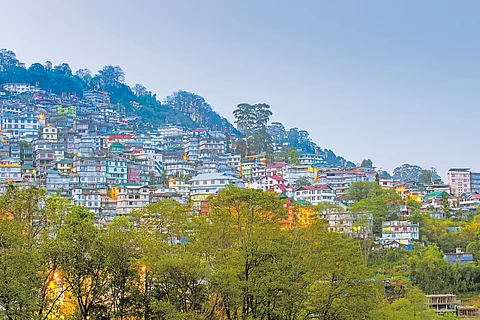

ISTOCK
High in the Himalayas, where clouds drift lazily across emerald hills and colourful prayer flags flutter in the wind, lies Gangtok, the capital of Sikkim. Perched at an altitude of around 1,650 metres, this hill town feels as though it has been carved out of the mountains themselves. It is a place where winding roads lead to breathtaking views, where ancient monasteries sit side by side with bustling markets, and where the scent of momos and steaming tea fills the air.
Gangtok is a town that seems to have everything. On one side, you have majestic peaks like Kanchenjunga, the world’s third-highest mountain, standing tall and snow-capped in the distance. On clear mornings, its golden summit catches the first rays of the sun, turning the mountain into a glowing beacon. For many visitors, catching that first glimpse of Kanchenjunga is an unforgettable experience. On the other side, Gangtok buzzes with life. MG Marg, the town’s main street, is a lively, pedestrian-only stretch lined with shops, cafes, and restaurants. Bright flowers hang from lampposts, benches invite tired travellers to sit, and the whole area feels warm and welcoming.
The town has a fascinating mix of cultures. Sikkim is home to Lepchas, Bhutias, and Nepalis, and Gangtok reflects this diversity in its food, festivals, and traditions. Walking through the markets, you might hear different languages being spoken, see women wearing traditional dresses called bakhus, and pass by stalls selling everything from prayer wheels to bamboo baskets. Around every corner, you’ll find a reminder that Gangtok is deeply connected to its Buddhist heritage. Monasteries like Rumtek and Enchey are not just places of worship but living centres of culture, where monks in crimson robes chant prayers that echo through the hills.
One of the most exciting things about Gangtok is how close it feels to nature. The town is surrounded by forests, waterfalls, and rivers that come alive in every season. In spring, rhododendrons bloom in brilliant shades of red and pink. In summer, the hills are lush and green. Winter brings chilly winds, misty mornings, and views of snow-covered peaks. Adventure-seekers love visiting places nearby like Tsomgo Lake, a stunning glacial lake that changes colour with the seasons, or Nathula Pass, a mountain pass on the historic Silk Route that connects India with Tibet. Just the drive to these places is an experience, with hairpin bends and valleys stretching far below.
Gangtok is also known for its unique food. Street vendors sell piping hot momos filled with vegetables or meat, while cafes serve thukpa, a delicious noodle soup that warms you on chilly days. For those with a sweet tooth, local bakeries offer freshly baked bread and cakes. The food here tells the story of a region influenced by Tibetan, Nepali, and Indian flavours all coming together.
Despite being a popular tourist destination, Gangtok has managed to stay clean and eco-friendly. Plastic bags are banned, and the town takes pride in keeping its streets spotless. MG Marg is a perfect example of this — not a scrap of litter can be seen, and even spitting is fined. The people of Gangtok have worked hard to preserve their environment, which makes visiting here feel even more special.
History lovers will find Gangtok equally fascinating. Sikkim was once an independent kingdom before it became part of India in 1975, and traces of its royal past still remain. The former royal palace, Raj Bhavan, and the Namgyal Institute of Tibetology are reminders of the region’s rich heritage. The institute, in particular, is worth exploring, as it houses rare manuscripts, statues, and thangkas (Tibetan scroll paintings) that reveal the deep Buddhist roots of Sikkim.
What makes Gangtok truly memorable is how it blends the old and the new. It has modern hotels, coffee shops, and even cable cars that give visitors sweeping views of the city. Yet, just a short walk away, you might find yourself standing before an ancient stupa, spinning a prayer wheel, or watching monks play long horns during a festival. This unique balance of tradition and modernity gives the town its special charm.
Gangtok is more than just a hill station; it is a gateway to the wonders of Sikkim. From here, travellers can set off on treks through high-altitude meadows, visit remote monasteries perched on cliff edges, or explore villages where time seems to stand still. Whether you are watching the clouds roll over Kanchenjunga, sipping tea in a small café, or simply walking along its quiet roads, Gangtok has a way of making you slow down and take it all in.
Gangtok was a small village until 1894, when the Chogyal (king) of Sikkim shifted his capital there from Tumlong.
The Royal Palace, built in 1908, is still the private residence of Sikkim’s last king’s descendants.
MG Marg allows no vehicles at all, making it rare among Indian hill stations
It comes from the Tibetan words ‘gang’ (hill) and ‘tok’ (top), a perfect description of this hill town’s location.
On a clear morning, the world’s third-highest mountain glows golden as the first rays of sunlight hit its snow-covered peak.
Gangtok’s cable car gives sweeping views of the entire town, surrounding valleys, and faraway mountains.
This glacial lake near Gangtok looks turquoise in summer, dark blue in winter, and is often surrounded by snow.
One of the largest monasteries in Sikkim, Rumtek houses a golden stupa containing relics of an important Buddhist teacher.
Sikkim, with Gangtok as its capital, was one of the first Indian states to ban plastic bags way back in 1998.